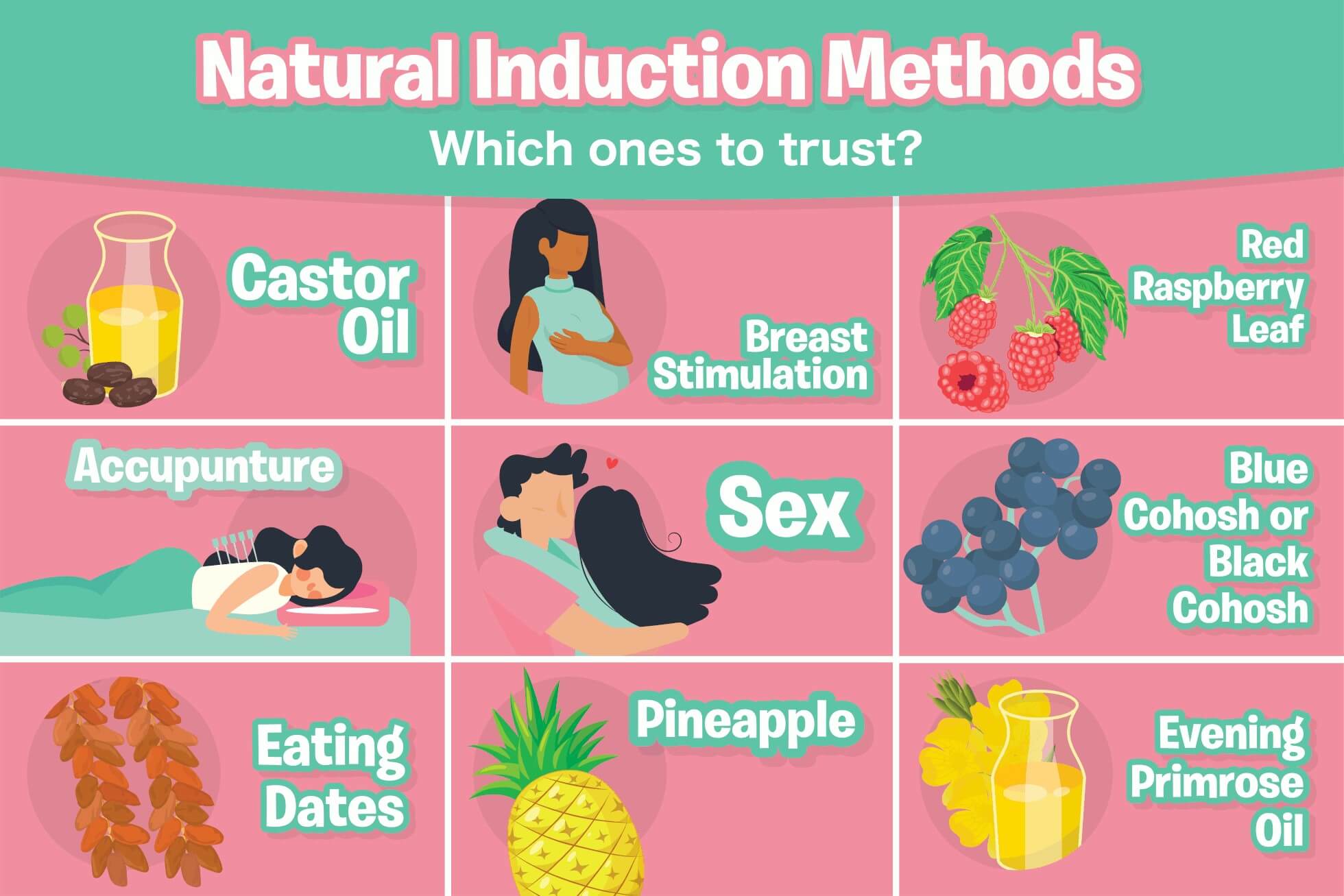9 Natural Induction Methods Examined: What Does the Evidence Say?


- Natural Labor induction is when a pregnant woman uses methods and techniques to help bring on labour.
- There is very little evidence to support whether natural pregnancy induction methods work.
- Some common myths carry risks. Always consult your doctor or midwife before trying.
Although natural labor induction has been performed for millennia, a dearth of scientific research exists on the topic. This can make it difficult to discern factual results from traditional wisdom. Though limited studies have been published, the information that does exist provides insight into purported natural labor triggers while also bringing the potential hazards of some methods to light. If you are considering inducing naturally, read up on what the science has to say about nine of the most common natural labor induction methods.
1. Castor Oil
The use of castor oil as a natural labor trigger dates at least as far back as Ancient Egypt. Studies have demonstrated that castor oil may have as high as a 58% chance of triggering active natural induce labor, but is also frequently accompanied by unpleasant side effects like nausea, vomiting and diarrhea. It is thought to work by promoting the release of prostaglandins, which may trigger cervical dilation. Castor oil should never be consumed in early pregnancy.
2. Breast Stimulation
Stimulation of the breasts as a method of inducing labor has seen medical literature mentions dating back more than 300 years. It is thought to work by triggering the release of oxytocin from the pituitary gland, which can lead to cervical ripening and labor. Studies have demonstrated that this method can be effective, leading to cervical ripening in up to 37% of cases, however, excessive attempts can lead to uterine hyperstimulation. Therefore, always proceed with caution and the support of your qualified caregiver.
3. Red Raspberry Leaf
Usually taken in the form of a tablet or tea, red raspberry leaf is purported to increase uterine blood flow and strength, potentially triggering contractions. Few studies exist on its use, and none exist correlating it with successfully triggering human labor. Though history demonstrates that its use may date back to the sixth century, this method produces little result in people, but was demonstrated to be a potential cause of early puberty in rats.
4. Sex
Often suggested by traditional wisdom as a natural induction trigger, sex is suggested to induce labor by introducing prostaglandins to the cervix, boosting oxytocin, and through the natural uterine activity caused by orgasm. While there are few negative side effects unless contraindicated, the minimal research that does exist on the role sex may play in labor notes that no difference in labor timing was seen between couples who did and did not have intercourse.
5. Acupuncture
An ancient Chinese ritual, acupuncture is the insertion of ultra-thin needles into the skin, thought by practitioners to redirect the body’s energy flow. As a natural labor trigger, it’s purported to work by stimulating the nervous system, triggering hormonal changes. Historical anecdotes infer that acupuncture may have been performed on pregnant and birthing women for millennia, but modern scientific studies can only link it to an improved cervical ripening score, not a trigger for active labor.
6. Blue and Black Cohosh
Blue and black cohosh are absolutely not considered safe methods of labor induction due to their potential to be toxic to your baby.
Sourced from different types of plants entirely, these two herbs are often used in conjunction with one another as a gynecological treatment as suggested by traditional Native American wisdom. Scientific studies show that these treatments do trigger strong uterine contractions, but may also be seriously harmful to mothers and children, potentially leading to serious labor and birth complications. Birth defects including a weakened heart may occur with use of blue and black cohosh.
7. Dates
Sweet and tasty, dates are thought in some cultures to trigger labor by producing oxytocin and introducing tannins to the body when eaten. Although clinical trials surrounding the use of dates don’t demonstrate the ability for the fruit to trigger labor, results did note some positive impact. Eating dates may lead to increased cervical ripening, decrease the need for Pitocin, and help minimize post-birth blood loss.
8. Pineapple
Bromelian, one of the active enzymes in pineapple, is believed by some to be a natural labor trigger. No clinical trials exist on the impact of eating pineapple on labor induction in humans, but a study performed on the uterine tissue of rats determined that in order for bromelian to trigger uterine contractions, it must be directly applied to tissue rather than digested. From this, we can extrapolate that eating pineapple is unlikely to play a role in labor.
9. Evening Primrose Oil
Typically consumed in capsule form, this common alternative medicine treatment is thought to trigger labor by increasing cervical ripeness. While little research exists on this treatment, studies have indicated that labor complications including the need for medical intervention during delivery. While it has the potential to improve the cervical ripening score, its use is discouraged due to potential health hazards.
About the author:
Neve Spicer is the creator and editor of WeTheParents, the evidence-based pregnancy and parenting guide. As a passionate advocate for mothers and a keen researcher, she seeks to empower women by highlighting and explaining scientific studies that can help guide and inform their parenting choices.
___
Nabta is reshaping women’s healthcare. We support women with their personal health journeys, from everyday wellbeing to the uniquely female experiences of fertility, pregnancy, and personalised support by using the Nabta app.
Get in touch if you have any questions about this article or any aspect of women’s health. We’re here for you.
Sources:
- Adewole, I F, et al. “Cervical Ripening and Induction of Labour by Breast Stimulation.” African Journal of Medicine and Medical Sciences, vol. 22, no. 4, Dec. 1993, pp. 81–85.
- Al-Kuran, O, et al. “The Effect of Late Pregnancy Consumption of Date Fruit on Labour and Delivery.” Journal of Obstetrics and Gynaecology, vol. 31, no. 1, 2011, pp. 29–31., doi:10.3109/01443615.2010.522267.
- Azhari, S, et al. “Evaluation of the Effect of Castor Oil on Initiating Labor in Term Pregnancy.” Saudi Medical Journal, vol. 27, no. 7, July 2006, pp. 1011–1014.
- Curtis, Peter. “Breast Stimulation to Augment Labor: History, Mystery, and Culture.” Birth, vol. 26, no. 2, June 1999, pp. 123–126., doi:10.1046/j.1523-536x.1999.00123.x.
- Datta, Sandipan, et al. “Toxins in Botanical Dietary Supplements: Blue Cohosh Components Disrupt Cellular Respiration and Mitochondrial Membrane Potential.” Journal of Natural Products, vol. 77, no. 1, 24 Jan. 2014, pp. 111–117., doi:10.1021/np400758t.
- Demaria, Andrea L., et al. “Castor Oil as a Natural Alternative to Labor Induction: A Retrospective Descriptive Study.” Women and Birth, vol. 31, no. 2, 2018, doi:10.1016/j.wombi.2017.08.001.
- Dove, D, and P Johnson. “Oral Evening Primrose Oil: Its Effect on Length of Pregnancy and Selected Intrapartum Outcomes in Low-Risk Nulliparous Women.” Journal of Nurse-Midwifery, vol. 44, no. 3, 1999, pp. 320–324., doi:10.1016/s0091-2182(99)00055-5.
- Holst, Lone, et al. “Raspberry Leaf – Should It Be Recommended to Pregnant Women?” Complementary Therapies in Clinical Practice, vol. 15, no. 4, Nov. 2009, pp. 204–208., doi:10.1016/j.ctcp.2009.05.003.
- Kavanagh, Josephine, et al. “Sexual Intercourse for Cervical Ripening and Induction of Labour.” Cochrane Database of Systematic Reviews, no. 2, 2001, doi:10.1002/14651858.cd003093.
- Smith, Caroline A, et al. “Acupuncture for Induction of Labour.” Cochrane Database of Systematic Reviews, no. 8, 15 Aug. 2013, doi:10.1002/14651858.cd002962.pub3.
- Smith-Levitin, Michelle, et al. “Severe Hyponatremia Associated with Use of Black Cohosh during Prolonged Labor and Unsuccessful Home Birth.” American Journal of Perinatology Reports, vol. 06, no. 01, 16 Mar. 2016, doi:10.1055/s-0036-1579537.
- Ty-Torredes, Karen Alessandra. “The Effect of Oral Evening Primrose Oil on Bishop Score and Cervical Length among Term Gravidas.” American Journal of Obstetrics and Gynecology, vol. 195, no. 6, Dec. 2006, p. S30., doi:10.1016/j.ajog.2006.10.078.













































